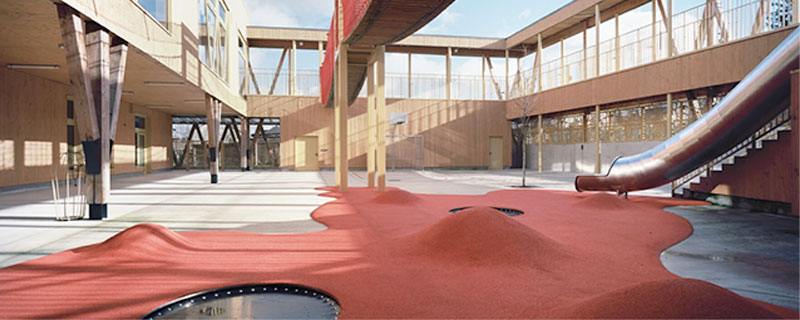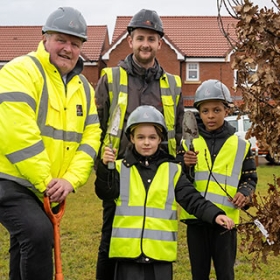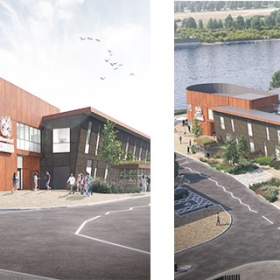Daylight and Nordic Influence enhances French School
image © Erieta Attali
Grenoble-based firm r2k architecte presents Oiseau Lyre, a school with Nordic inspiration in Noisy-le-Grand, France. Anchored on a plot with eight meters of elevation, the school faces North toward the Marne and explores a new pedagogical model of Finnish design, offering a diversity of shared spaces. The compact building of 50mx100m is set on four levels, maintaining a low height profile about neighboring pavilions. Like a Palladian villa, functions are embedded in the core of the building, in an area filled with natural light and the social vibrancy of the school. With Oiseau Lyre, r2k architecte brings the city’s environmental and educational ambitions to realization by shaping a positive energy building made of wood. Based on recent cognitive research, it provides a framework for active pedagogies. In its spatial proposals, the school’s design incorporates the latest know-how of Nordic schools, and those of the Quebec Lab school, models which r2k architects Véronique Klimine (France) and Olavi Koponen (Finland) visited.
A vibrant and multipurpose building complex
The program at Oiseau Lyre by r2k architecte includes 24 classrooms for kindergarten and elementary students, as well as eight rooms intended as recreation spaces. Common spaces, including a multipurpose room with direct external access, a motor room, an art gallery, a library, a restaurant, and a sports hall are shared with civic associations when school is out. On a steep slope facing the Marne River, three levels of the four-level school are connected to the natural terrain, facilitating the safety of children. Located in the middle of a vernacular district, the project also respects the proportions of surrounding houses. On the playground, the design focuses on fun, proprioception, and participation of everyone in games of exploration, balance, running, and climbing. A walk-in cloister, enclosed by an ‘aerial suspension bridge’, continues its descent via a slide on the bumpy ground of the courtyard. In response to the City’s preference for a relatively dry area, the architects were able to locate the more natural part at the bottom of the plot, overlooking the Marne.
Biophilic, renewable, and low-carbon wooden design
The project welcomes natural light into the heart of school spaces, despite its diminutive size of just 50mx100m. It is sculpted with light thanks to sheds, skylights, interior glazing, and more that highlight wood materials in the heart of the building through the atrium and the steps. Light and materiality are essential parts of well-being and, from the interior spaces, the view of the private gardens greatly contributes to a peaceful atmosphere. Acoustics defined by wooden ceilings, as well as indirect lighting, complete the soothing environment. The school’s ‘living wood’ consists of visible constructive elements and refined coatings, with pleated cladding cut to measure.
A renewable resource and carbon sink, wood provides both aesthetic and functional solutions while promoting the integration of a new urban element into the vernacular environment. Each zone in Oiseau Lyre has its structural typology, with truss lattices forming sheds, tree columns/ plank round wood, ribbed CLT floors, LVL accessible roof floor coffers, wood frame walls, CLT splits, and wooden beam posts as a primary skeleton. Crossing through the elementary courtyard to the gym, trusses of 22m are arranged in a shed to form a courtyard that introduces a soft light and supports the solar panels. A ribbed LVL floor supporting the courtyard crosses 22m on 4 supports above the gym, and are the largest caissons of this type ever made. The playgrounds’s rooftops were points of constructive innovation.
Moving on to low carbon considerations, multiple factors must be addressed to achieve the result of a building producing more energy than it consumes. The first involves limiting thermal losses. The second requires capturing renewable energies in passive and active ways, which is achieved by integrating photovoltaic panels located on the south side of the sheds. Electrical, kitchen, and double-flow ventilation equipment were chosen for their sobriety, making natural ventilation of the classrooms possible. Protective equipment against direct external sunlight is also installed, while internal floor heating is achieved thanks to a dozen geothermal probes.
How r2k architecte introduces nordic pedagogies
Interpretations of the merits of learning modes and different pedagogies possible in schools have dramatically evolved through cognitive studies. These changes revolve around two key concepts: (1) A child’s understanding is not a direct result of the teaching, but is rather an active by-product of the child’s research on a personal path. (2) The most impactful school learning takes place not in isolation, but in open environments within the school, society, and the world. In addressing these issues, that means school buildings require the following: Different spaces in size, atmosphere, privacy, and facilities; Safety openings for individual or team work; ability to adapt learning locations.
For Oiseau Lyre, the architects were able to incorporate some of those principles: Participatory educational spaces for two or three classes to expand the circulation in appropriate pockets; Enabling children to acquire autonomy outside of strict classroom settings through interactions with other students for work or social exchanges; Facilitate the use of bleachers and the atrium to enable groups to participate in emulation and inventiveness through spatial situations conducive to appropriation, staging, active pedagogy, etc. These devices were observed in Finnish schools that the architects visited with Olavi Koponen before the competition.
The Schools Prize, organized by the team of P’tits Archis around mediation workshops on the themes of architecture and urbanism, rewarded L’OISEAU LYRE. During the third edition, four classes of elementary schools in Ile-de-France dicussed their favorite wood projects during awareness workshops mixing discovery of candidate projects, making mock-ups, and voting for their favorite project in the ‘Learn – Have Fun’ category. Delivered in September 2022 to welcome its first students, the school will ramp up operations in 2023/ 2024 with the arrival of new inhabitants of the neighboring eco-district.
Source: Design Boom





Leave a Reply
Want to join the discussion?Feel free to contribute!